
The history of hand signals on the trading floor began around the middle of the 19th century. Brokers and traders found themselves unable to reconcile the distance between their personal staffs working feverishly in offices high above the pit and the pit itself. Facing increasing competition for real estate on the trading floor, fights broke out over positions in the pit which afforded better views of some trading board or brokerage service window, from which information could be retrieved, interpreted, and acted upon. Some brokers even began looking into hiring exceptionally tall men, to gain the literal advantage of foresight!
To combat this, a number of systems began coming into place. The chief concern, of course, was how to pass information quickly and directly to a trader on the floor without revealing the information to all. Simply shouting out orders would have been useless anyway, considering the noisy uproar of the marketplace, but would also have defeated the purpose of subterfuge and advantage that arbitrage provided. Arb, short for arbitrage, is the system of hand signals used to communicate buy and sell information in an open-outcry trading environment.
The hand signals are the favored form of floor communication for speed and efficiency, practicality, and confidentiality. Hand signals enable fast communication over potentially long distances (as much as 30 or 40 yards), and are more practical than voice communication due to the noise level and number of people on the floor. Within the trading pit today, hand signals and trading cards are still used in open-outcry trading to translate information. Here are some common hand signals used on the trading floor.
Buy Sell

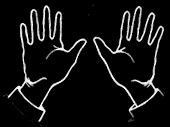
When indicating you want an offer to buy, the palm of the hand always faces toward you. When indicating you want an offer to buy, the palm of the hand always faces toward you.
Quantity
To indicate quantity - the number
of contracts being bid or offered - touch your face.
1-9 Multiples of 10 Multiples of 100
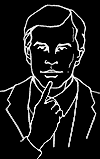
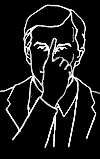

To signal quantities one through nine, touch your chin.
To show quantities in multiples of 10, touch the forehead.
To show quantities in multiples of 100, make a fist and touch the forehead.
Stop
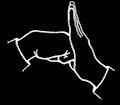
Fist into palm; means that the order is a stop order (activated when the price reaches a certain level). At that point, a stop order becomes a market order and the broker must attempt to get the best price when filling it. Can be used to enter or exit both long and short positions. For example, if you are long and fear a drastic price drop, you can issue a stop order to be activated when the contract drops to a given price. Your stop then becomes a market order that the broker will attempt to fill before the price drops even more - even if it requires selling at or below the stop price. Likewise, a short can issue a "buy" stop order if he fears the price will rise.
Out/Cancel
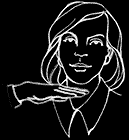
Hand moves across throat; shows
that the order has been canceled.
Options
Put Call

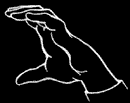
In options trading on the CME floor, traders need to indicate whether an order is a put or a call, in addition to using the standard signals to convey other information about the order.
